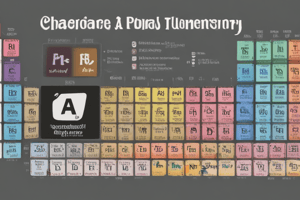Podcast
Questions and Answers
What is the total number of known elements?
What is the total number of known elements?
- 100
- 125
- 118 (correct)
- 120
What determines the classification of elements as metals, nonmetals, or metalloids?
What determines the classification of elements as metals, nonmetals, or metalloids?
- Atomic number
- Their properties (correct)
- Atomic mass
- Their electron shells
How do the atomic radius and atomic mass of elements change when moving from left to right across a period?
How do the atomic radius and atomic mass of elements change when moving from left to right across a period?
- Atomic radius increases, atomic mass decreases
- Atomic radius and atomic mass both increase
- Atomic radius and atomic mass both decrease
- Atomic radius decreases, atomic mass increases (correct)
What is the main difference between periods and groups in the periodic table?
What is the main difference between periods and groups in the periodic table?
What do elements in the same group have in common?
What do elements in the same group have in common?
How do the atomic number and atomic mass of elements change when moving down a group?
How do the atomic number and atomic mass of elements change when moving down a group?
Flashcards are hidden until you start studying
Study Notes
Elements
- A periodic table is composed of elements, which are the building blocks of matter.
- There are 118 known elements, each with a unique atomic number (number of protons in the nucleus) and atomic mass (total number of protons and neutrons).
- Elements are represented by a one- or two-letter symbol, known as the elemental symbol.
- Elements can be classified as metals, nonmetals, or metalloids based on their properties.
Periods
- The periodic table is arranged in periods, which are horizontal rows.
- There are 7 periods in the periodic table, each representing a new energy level.
- Elements in the same period exhibit similar trends in physical and chemical properties due to the same number of electron shells.
- Moving from left to right across a period, the elements exhibit increasing atomic number, increasing atomic mass, and decreasing atomic radius.
Groups
- The periodic table is also arranged in groups, which are vertical columns.
- There are 18 groups in the periodic table, each representing a new family of elements.
- Elements in the same group exhibit similar chemical properties due to the same number of electrons in their outermost energy level.
- Moving down a group, the elements exhibit increasing atomic number, increasing atomic mass, and increasing atomic radius.
Studying That Suits You
Use AI to generate personalized quizzes and flashcards to suit your learning preferences.




